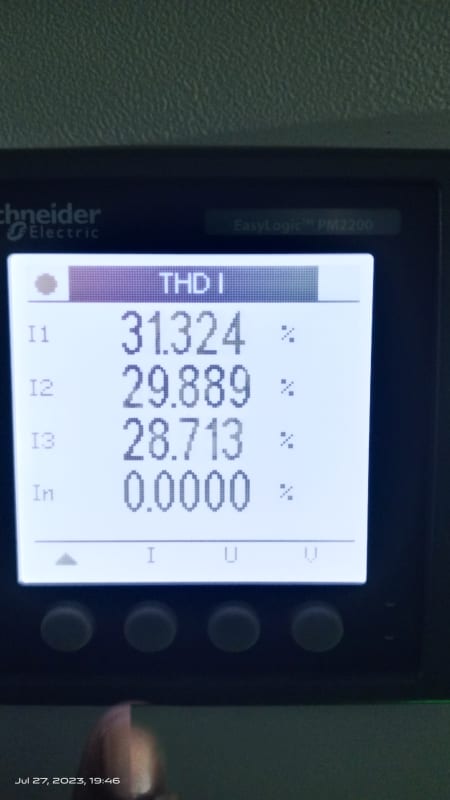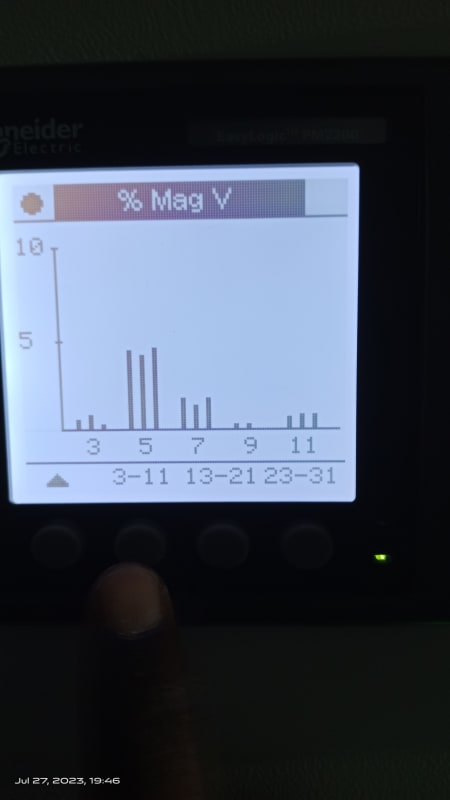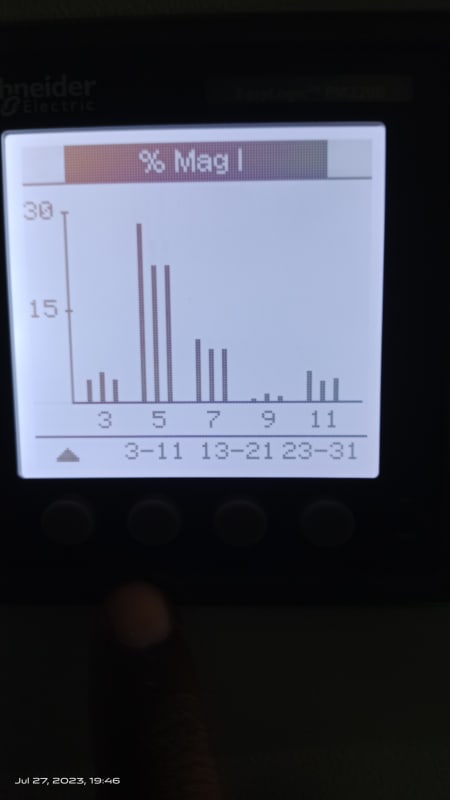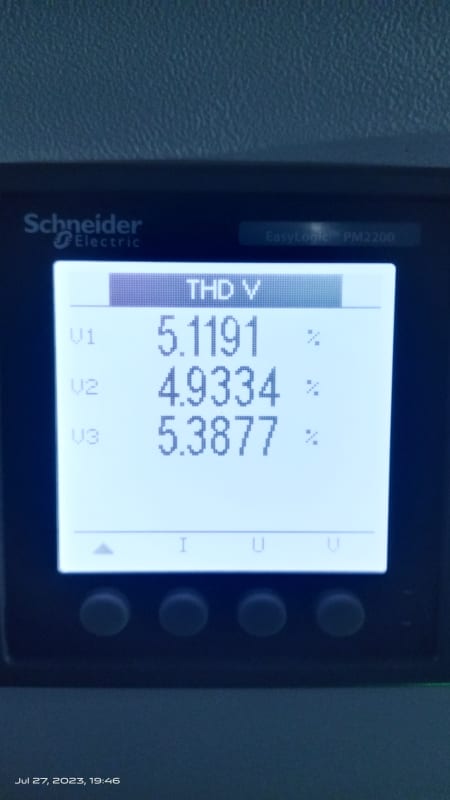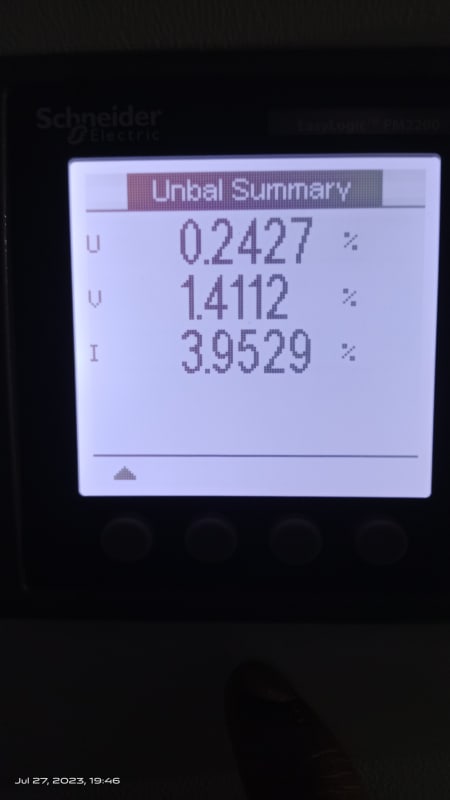Navigation
Install the app
How to install the app on iOS
Follow along with the video below to see how to install our site as a web app on your home screen.
Note: This feature may not be available in some browsers.
More options
Style variation
-
Congratulations cowski on being selected by the Eng-Tips community for having the most helpful posts in the forums last week. Way to Go!
You are using an out of date browser. It may not display this or other websites correctly.
You should upgrade or use an alternative browser.
You should upgrade or use an alternative browser.
Harmonics in 250kW VFD 2
- Thread starter Histor
- Start date
- Status
- Not open for further replies.
Hello,
Can you provide a diagram of all the equipment that is connected to the same incoming line?
Is there a bank of capacitors?
A resonant circuit with capacitance and inductance may generate a significant amount of circulating current near to the resonant frequency. It's usual to size a capacitor bank so that it provides enough capacitance to lower the DPF to at least 0.9 while not causing the voltage to lag the current. The resulting configuration produces resonant frequencies between the 5th and 7th harmonics.
If the circuit has a source of harmonics close to the resonant frequency, issues may arise. The VFD's semiconductor switching operation can be the source of that harmonics, and the problem gets worse if the source impedance is too high to effectively absorb harmonic currents without causing severe voltage distortion.
Can you provide a diagram of all the equipment that is connected to the same incoming line?
Is there a bank of capacitors?
A resonant circuit with capacitance and inductance may generate a significant amount of circulating current near to the resonant frequency. It's usual to size a capacitor bank so that it provides enough capacitance to lower the DPF to at least 0.9 while not causing the voltage to lag the current. The resulting configuration produces resonant frequencies between the 5th and 7th harmonics.
If the circuit has a source of harmonics close to the resonant frequency, issues may arise. The VFD's semiconductor switching operation can be the source of that harmonics, and the problem gets worse if the source impedance is too high to effectively absorb harmonic currents without causing severe voltage distortion.
-
1
- #3
davidbeach
Electrical
You’re feeding a 6 pulse rectifier. Nothing to see here, move along… 
I’ll see your silver lining and raise you two black clouds. - Protection Operations
I’ll see your silver lining and raise you two black clouds. - Protection Operations
- Thread starter
- #4
davidbeach
Electrical
Only you can answer that. I don’t think it’s a problem, but I’m not there, where ever there is.
I’ll see your silver lining and raise you two black clouds. - Protection Operations
I’ll see your silver lining and raise you two black clouds. - Protection Operations
A three phase rectifier that is balanced will draw ODD harmonics minus the triplens, so expect to see 5th, 7th, 11th, 13th .... with the amplitude reducing as the harmonic number increases. (multiples of 3 balance out.)
Harmonic mitigation may be required by regulation. - it is needed in some utilities.
Harmonic voltage may cause problems to other equipment on the same supply, in this case apply mitigation.
Commonly, maximum harmonic voltage limit is 5%. You are right on the limit if this is a requirement in you installation.
Mark Empson
Advanced Motor Control Ltd
Harmonic mitigation may be required by regulation. - it is needed in some utilities.
Harmonic voltage may cause problems to other equipment on the same supply, in this case apply mitigation.
Commonly, maximum harmonic voltage limit is 5%. You are right on the limit if this is a requirement in you installation.
Mark Empson
Advanced Motor Control Ltd
There are generally TWO limits for harmonic content. One is the voltage harmonic (THDv)- which is effectively per IEEE 519. It used to be a maximum of 5% (total) with the single largest harmonic limited to 3%. In some instances / applications where there is a much higher percentage of switched electronics as loads, this increases to 8 % (total) and 5% for any single).
The other - and often more important one - is the current harmonic (THDi). The problem here is (usually) thermal stress - recall that losses (i.e. heat) are proportional to the square of the current. Most equipment doesn't like to be put into a continuous overload condition - which is when the current exceeds nameplate - which it will do, when THDi is any appreciable amount.
One other thing to note - the limits apply at rated conditions (voltage, current). It is highly likely that a "no load" measurement is going to produce some really weird harmonic content as you're essentially down in the "noise" range. So at what load condition(s) are these measurements taken? And, since you didn't mention it - which side of the drive are they taken - the upstream (bus) side or the downstream (load) side?
Seeing 30+% current harmonic at rated load conditions would be a cause for instant shutdown in my book, if it was on the output of the drive (i.e. input to the downstream machine).
Converting energy to motion for more than half a century
The other - and often more important one - is the current harmonic (THDi). The problem here is (usually) thermal stress - recall that losses (i.e. heat) are proportional to the square of the current. Most equipment doesn't like to be put into a continuous overload condition - which is when the current exceeds nameplate - which it will do, when THDi is any appreciable amount.
One other thing to note - the limits apply at rated conditions (voltage, current). It is highly likely that a "no load" measurement is going to produce some really weird harmonic content as you're essentially down in the "noise" range. So at what load condition(s) are these measurements taken? And, since you didn't mention it - which side of the drive are they taken - the upstream (bus) side or the downstream (load) side?
Seeing 30+% current harmonic at rated load conditions would be a cause for instant shutdown in my book, if it was on the output of the drive (i.e. input to the downstream machine).
Converting energy to motion for more than half a century
-
1
- #8
LionelHutz
Electrical
There are generally TWO limits for harmonic content.
Fundamentally, the harmonic limits are what doesn't cause issues in your building or have your utility knocking on your door because other nearby customers are complaining. IEEE519 is a recommended practice, which you could apply to the input of a VFD if you chose to. But, the only time you might be required to meet IEEE519 would be at the consumer-utility interface due to a utility requirement. What you do inside your facility is your own business.
Most equipment doesn't like to be put into a continuous overload condition - which is when the current exceeds nameplate - which it will do, when THDi is any appreciable amount.
This isn't true, a correctly built VFD system is perfectly fine running at 30% THDi on the input side.
We ship VFD systems every day with line reactors and these will always produce a similar harmonic spectrum. I never hear any complaints about equipment being overloaded due to harmonics. Many times, the specification requires it meets IEEE519, but quoting a harmonic filter would just lose the job and in practice no-one actually cares even though it was specified.
The last time I dealt with a stickler customer that required a harmonic filter and it also had to be tested it didn't go so well for the customer. With the VFD running at full speed and load, the power meter was showing harmonics over the IEEE519 limits and they were pointing out that it's not working. I then stopped the VFD and the harmonics were still over the limits. So, then I get to ask back what they expect me to do about it.
And, since you didn't mention it - which side of the drive are they taken - the upstream (bus) side or the downstream (load) side?
It's obviously the line side input to the VFD, with that 6-pulse rectifier spectrum.
Hi Lionel
That is a good summary from a suppliers perspective and I believe would be pretty well the defacto attitude towards harmonics across the board.
Here, in New Zealand, we do have rural areas where the accumulation of the harmonic currents on the local network can result in harmonic voltages at levels where there are major problems with other equipment connected on the same network. I have seen harmonic voltages on the 11KV and 22KV distribution network that have been as high as 16% voltage distortion (not current distortion) and so at that level, there are many items of equipment that can be damaged or interfered with.
I have seen rotors of submersible pumps that have been badly damaged by harmonic voltages.
In these areas, the supply authorities have mandated harmonic mitigation and so it is very common practice for us to harmonically mitigate drives in the rural areas. Yes, it doubles the cost, but without mitigation, you are not allowed to install a VFD in these areas. Some networks test every drive installation for THDi compliance.
We would supply harmonic mitigation with around 60% of our VFD sales, and in some regions it would be 100%.
Generally, where harmonic current levels are imposed, this is based on the harmonic voltage contribution and so is related to the fault current ratio (supply impedance)
In many areas, harmonics are still ignored and will probably continue so until there is a problem that is identified and proven to be harmonic related.
In some areas, we are experiencing significant common mode problems due to active filters and active front end VFDs. At this stage, we have no standard/regulation covering this, but if you have a low fault current ratio, the common mode currents can cause significant high frequency voltages on the network, but typically around 8 - 10 KHZ which is beyond the harmonic regulations, and below the 150KHz conducted emissions limits.
If the fault current ration is below 20, what for common mode voltage problems and harmonic voltage problems.
Best regards,
Mark Empson
Advanced Motor Control Ltd
That is a good summary from a suppliers perspective and I believe would be pretty well the defacto attitude towards harmonics across the board.
Here, in New Zealand, we do have rural areas where the accumulation of the harmonic currents on the local network can result in harmonic voltages at levels where there are major problems with other equipment connected on the same network. I have seen harmonic voltages on the 11KV and 22KV distribution network that have been as high as 16% voltage distortion (not current distortion) and so at that level, there are many items of equipment that can be damaged or interfered with.
I have seen rotors of submersible pumps that have been badly damaged by harmonic voltages.
In these areas, the supply authorities have mandated harmonic mitigation and so it is very common practice for us to harmonically mitigate drives in the rural areas. Yes, it doubles the cost, but without mitigation, you are not allowed to install a VFD in these areas. Some networks test every drive installation for THDi compliance.
We would supply harmonic mitigation with around 60% of our VFD sales, and in some regions it would be 100%.
Generally, where harmonic current levels are imposed, this is based on the harmonic voltage contribution and so is related to the fault current ratio (supply impedance)
In many areas, harmonics are still ignored and will probably continue so until there is a problem that is identified and proven to be harmonic related.
In some areas, we are experiencing significant common mode problems due to active filters and active front end VFDs. At this stage, we have no standard/regulation covering this, but if you have a low fault current ratio, the common mode currents can cause significant high frequency voltages on the network, but typically around 8 - 10 KHZ which is beyond the harmonic regulations, and below the 150KHz conducted emissions limits.
If the fault current ration is below 20, what for common mode voltage problems and harmonic voltage problems.
Best regards,
Mark Empson
Advanced Motor Control Ltd
- Status
- Not open for further replies.
Similar threads
- Question
- Replies
- 20
- Views
- 28K
- Replies
- 10
- Views
- 1K
- Question
- Replies
- 9
- Views
- 4K
- Locked
- Question
- Replies
- 6
- Views
- 545
- Locked
- Question
- Replies
- 23
- Views
- 11K

